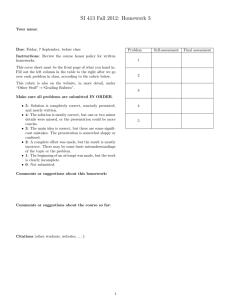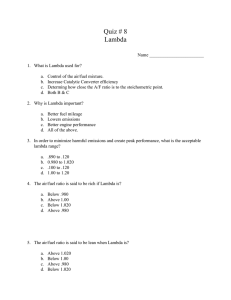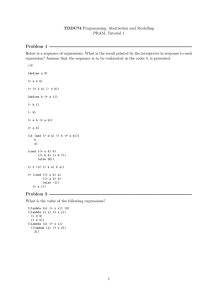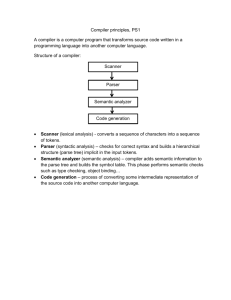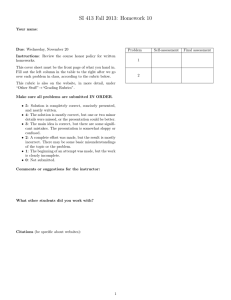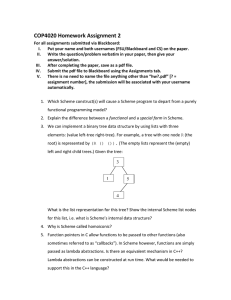, April 30, 2010 18.03 Class 34 Complex or repeated eigenvalues
advertisement
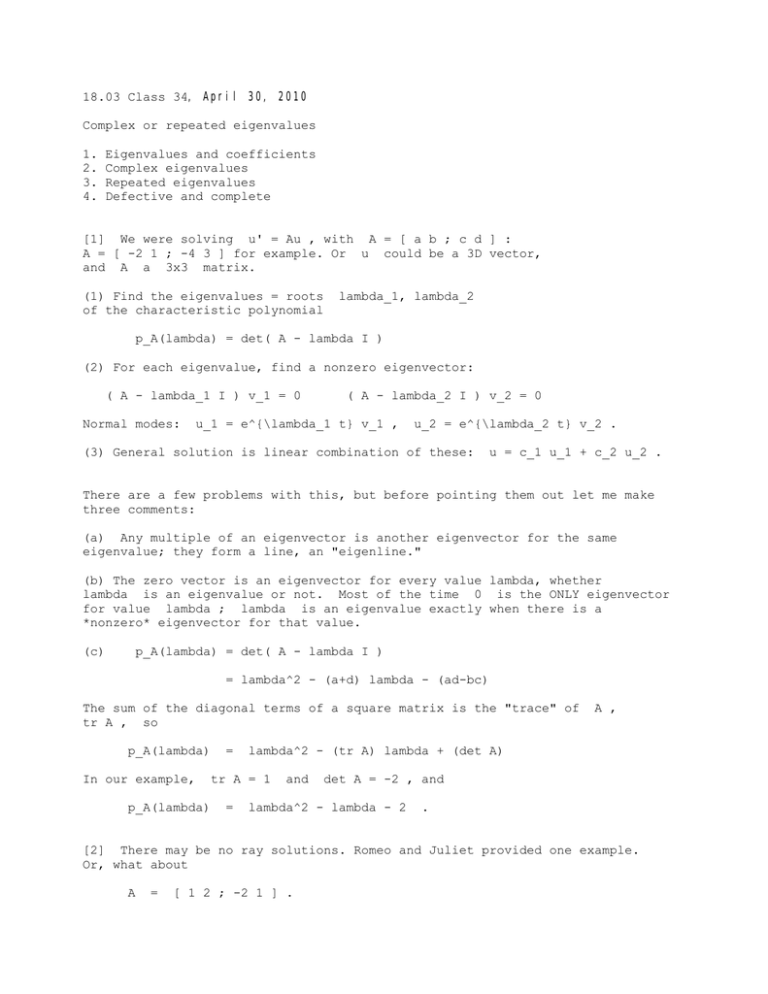
18.03 Class 34, April 30, 2010
Complex or repeated eigenvalues
1.
2.
3.
4.
Eigenvalues and coefficients
Complex eigenvalues
Repeated eigenvalues
Defective and complete
[1] We were solving u' = Au , with A = [ a b ; c d ] :
A = [ -2 1 ; -4 3 ] for example. Or u could be a 3D vector,
and A a 3x3 matrix.
(1) Find the eigenvalues = roots
of the characteristic polynomial
lambda_1, lambda_2
p_A(lambda) = det( A - lambda I )
(2) For each eigenvalue, find a nonzero eigenvector:
( A - lambda_1 I ) v_1 = 0
Normal modes:
( A - lambda_2 I ) v_2 = 0
u_1 = e^{\lambda_1 t} v_1 ,
u_2 = e^{\lambda_2 t} v_2 .
(3) General solution is linear combination of these:
u = c_1 u_1 + c_2 u_2 .
There are a few problems with this, but before pointing them out let me make
three comments:
(a) Any multiple of an eigenvector is another eigenvector for the same
eigenvalue; they form a line, an "eigenline."
(b) The zero vector is an eigenvector for every value lambda, whether
lambda is an eigenvalue or not. Most of the time 0 is the ONLY eigenvector
for value lambda ; lambda is an eigenvalue exactly when there is a
*nonzero* eigenvector for that value.
(c)
p_A(lambda) = det( A - lambda I )
= lambda^2 - (a+d) lambda - (ad-bc)
The sum of the diagonal terms of a square matrix is the "trace" of
tr A , so
p_A(lambda)
In our example,
=
lambda^2 - (tr A) lambda + (det A)
tr A = 1
p_A(lambda)
=
A ,
and
det A = -2 , and
lambda^2 - lambda - 2
.
[2] There may be no ray solutions. Romeo and Juliet provided one example.
Or, what about
A
=
[ 1 2 ; -2 1 ] .
Let's apply the method and see what happens.
tr(A) = 2 , det(A) = 5,
so
p_A(lambda) = lambda^2 - 2 lambda + 5 = (lambda - 1)^2 + 4
which has roots
lambda_1 = 1 + 2i,
lambda_2 = 1 - 2i.
We could abandon the effort at this point, but we had so much fun and
success with complex numbers earlier that it seems we should carry on.
Find an eigenvector for
lambda_1 = 1 + 2i :
A - (1+2i)I : [ - 2i 2 ; -2 -2i ][ ? ; ? ]
=
[ 0 ; 0 ]
Standard method: use the entries in the top row in reverse order with
one sign changed: [ 2 ; 2i ] or, easier, in this case,
v_1
=
[ 1 ; i ].
This is set up so the top entry in the product is 0 . We have a chance
to check our work (mainly the calculation of the eigenvalues) by
seeing that the bottom entry in the product is 0 too:
-2 . 1 - 2i . i
=
0
[ 1 ; i ] is a vector with complex entries. OK, so be it. It's hard
to visualize, perhaps, and doesn't represent a point on the plane, but
we can still compute with it just fine.
Since lambda_2 = conjugate of lambda_1,
an eigenvector for lambda_2 is given by the conjugate of
v_2
=
v_1:
[ 1 ; -i ]
So the normal modes
v(t) = e^{(1+2i)t} [ 1 ; i ]
,
_
v(t) = e^{(1-2i)t} [ 1 ; -i ] .
As in the case of second order equations, the real and imaginary parts
of solutions are again solutions,
_
_
u1 = (v + v)/2 = Re(v) ,
u2 = (v - v)/(2i)
and we really only need to write down one of the normal modes.
So these are real solutions:
u
u1
u2
=
e^{(1+2i)t} [ 1 ; i ]
=
e^t ( cos(2t) + i sin(2t) ) ( [1;0] + i[0;1] )
=
Re(u)
=
e^t [cos(2t) ; - sin(2t)]
=
Im(u)
=
=
e^t ( cos(2t) [1;0] - sin(2t) [0;1] )
and
e^t ( cos(2t) [0;1] + sin(2t) [1;0] )
so
=
e^t [sin(2t) ; cos(2t)]
These are two independent real solutions. Both spiral around the origin,
clockwise, while fleeing away from it exponentially. They satisfy
u1(0)
=
[1;0]
,
u2(0)
=
[0;1] .
I showed their trajectories on the Mathlet Linear Phase Portraits: Matrix
Entry.
The general real solution is
a u1 + b u2
,
a,
b real .
It is very hard for me to visualize the fact that all
those spirals are linear combinations of any two of them.
Summary: Nonreal eigenvalues lead to spiral solutions.
Positive real parts lead to solutions going to infinity with t ("unstable")
Negative real parts lead to solutions going to zero with t ("stable")
Zero real parts lead to solutions parametrizing ellipses.
So we discover that the possibility of complex eigenvalues really isn't a
failure of the method at all. There are in fact ray solutions, but they are
complex and don't show up on our real phase plane.
[3]
Second problem with our method: Illustrated by
A
=
[ -2 1 ; -1 0 ]
p_A(lambda)
=
lambda^2 + 2 lambda + 1 = (lambda + 1)^2
which has only one root, "repeated":
lambda_1 = lambda_2 = -1.
Still, find an eigenvector:
A - (-1)I
=
[ -1 1 ; -1 1 ][ ? ; ? ]
=
[ 0 ; 0 ] :
v
=
[ 1 ; 1 ]
or any nonzero multiple. ALL eigenvectors for A lie
on the line containing 0 and [ 1 ; 1 ]. I showed a picture of the
phase portrait, which shows only one pair of opposed ray trajectories.
So there is (up to multiples) only one normal mode:
u_1
=
e^{-t} [ 1 ; 1 ]
But we need another solution. Here is how to find one; I won't go into
details, just give you the method.
Write down the same matrix
that
(A - lambda1 I) w
Then
=
A - lambda_1 I
v .
but now find a vector
w
such
u_2
=
e^{lambda_1 t} (t v + w)
is a second solution.
In our case:
[ -1 1 ; -1 1 ] [ ? ; ? ]
has solution
u_2
[0;1] ,
=
[ 1 ; 1 ]
so
=
e^{-t} ( t [1;1] + [0;1] )
=
e^{-t} [ t ; t+1 ]
[0;1] isn't the only vector that works here; [0;1] + c v
for any constant c. It doesn't matter which one you pick.
With this choice,
u_1(0) = [1;1]
,
does too
u_2(0) = [0;1] .
The general solution is
u
=
a u_1 + b u_2 .
To learn more about all this you should take 18.06.
Didn't get to talk about this on Friday:
[4] A matrix with a repeated eigenvalue but only one lineful of
eigenvectors is called "defective." A matrix can have a repeated
eigenvalue and not be defective:
A
=
[ 2 0 ; 0 2 ]
for example has characteristic polynomial
p(lambda)
so
=
lambda^2 - 4 lambda + 4
lambda_1 = lambda_2 = 2.
A - lambda_1 I :
=
(lambda - 2)^2
To find an eigenvector consider
[ 0 0 ; 0 0 ] [ ? ; ? ]
=
[ 0 ; 0 ]
Now ANY vector is an eigenvector! Instead of only one line you get the
entire plane. For any vector v ,
e^{2t} v
is a solution, and every solution is a normal mode. This is called the
"complete" case.
In the 2x2 case, if the eigenvalue is repeated you are in the defective
case unless the matrix is precisely
[ \lambda_1 , 0 ; 0 , \lambda_1 ]
MIT OpenCourseWare
http://ocw.mit.edu
18.03 Differential Equations
��
Spring 2010
For information about citing these materials or our Terms of Use, visit: http://ocw.mit.edu/terms.

